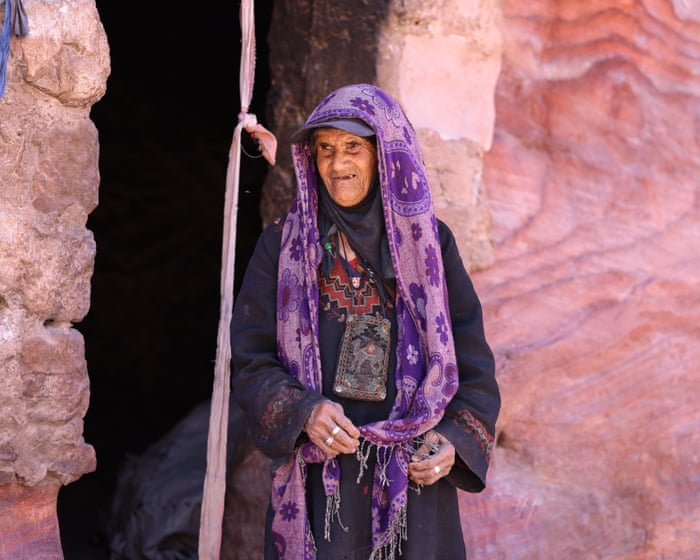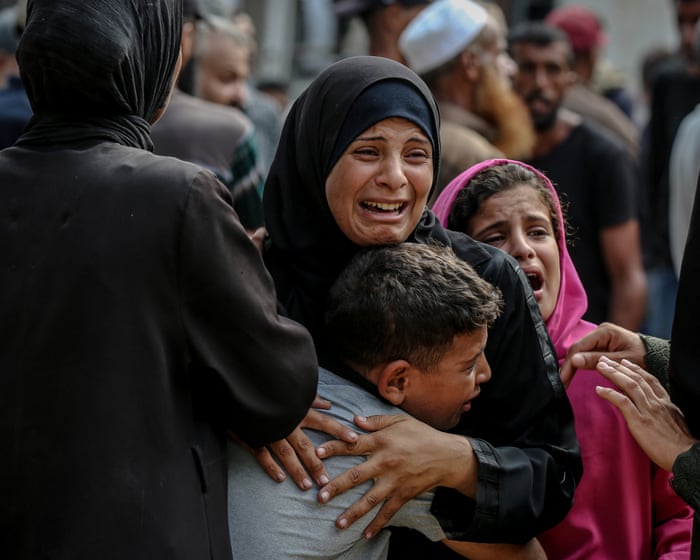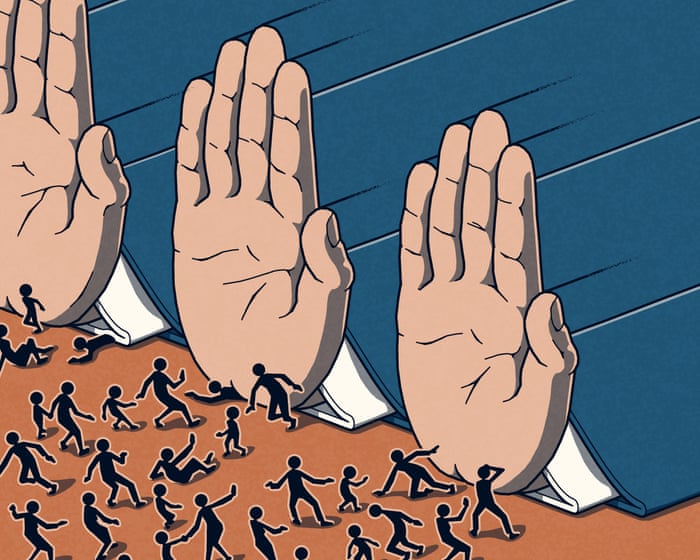By noon, the sun hangs high over Petra, bleaching the colorful sandstone cliffs and briefly clearing the famous ruins of tourists. Vines and a canopy keep the terrace of Mohammed Feras’s cave home cool, despite the intense summer heat rising from the rocky valley below.
“I’ve lived here my whole life. I’ve never been anywhere else, and I can’t imagine living anywhere but here. This place is part of who I am—I can’t leave it,” said the 44-year-old farmer, who also works occasionally as a tour guide.
Within months, Feras and dozens of other Bedouin from the Bdoul community are likely to be forced from the caves they call home. There is little room for them in Petra as it undergoes a major development program aimed at building new facilities, regulating the chaotic tourist trade, and improving the experience for the hundreds of thousands of visitors drawn to the ancient site.
Feras lives with his wife and nine children in four connected caves that are 2,400 years old, along with an adjoining tent. Just a 10-minute walk away are the remains of Petra’s grand temple and its column-lined main street. It’s also a short hike from the famous Treasury monument, which gained wider recognition from the 1989 blockbuster Indiana Jones and the Last Crusade.
The caves occupied by the Bdoul were originally part of a wealthy trading city—the thriving capital of the Nabateans for 500 years before it was taken over by the Romans around AD 100 and eventually abandoned three centuries later.
International human rights advocates have urged Jordanian authorities to stop the impending evictions. “Jordan’s displacement of the Bdoul from their historic homes in Petra puts their culture at risk,” said Adam Coogle, deputy director for the Middle East and North Africa at Human Rights Watch. “The Jordanian government should halt the relocations and respect the rights of Petra’s Bedouin community.”
Officials in charge of managing and developing Petra say the Bdoul still living on-site are there illegally. They argue that many have other housing options and that using the caves as homes, animal shelters, shops, and storage spaces risks causing permanent damage.
“If we want to preserve the site’s integrity for future generations, we have to stop activities that harm the caves,” said Dr. Fares Braizat, chief commissioner of the Petra Development and Tourism Region Authority. “Everyone on-site must follow the law, and it is illegal for anyone to live in or use the archaeological monuments within Petra for any purpose.”
Historians note that the Bdoul have lived in Petra’s caves for about 200 years. Efforts to remove the community began shortly after Petra was designated a UNESCO World Heritage Site in 1985. At that time, a deal was negotiated with community leaders, and thousands of people were moved to a purpose-built village nearby. Some avoided relocation or later returned to their cave homes.
In recent years, with tourism playing a key role in Jordan’s struggling economy, significant investments have been made in Petra. A new museum, cultural village, and network of walking trails have been developed. Hundreds of stalls that once crowded the site have been removed, as have guides who harassed visitors. Authorities have also tried to curb overnight stays in caves being advertised to tourists on social media and booking sites.
The latest effort to clear the caves began in late 2024, targeting around a dozen extended families now living near the Sutuh al-Nabi Harun mountain. Campaigners have accused Jordanian authorities of using “coercive tactics.”
Feras, who makes a modest living raising goats and sheep and occasionally guiding tourists, has turned down an offer from authorities to relocate.Feras, a member of the Bdoul community from Petra, now lives in a house in a village where other Bdoul have been relocated. He explained that he was imprisoned earlier this year for failing to pay a large fine after being accused of damaging a heritage site. Although he was released after two weeks, he now faces another court hearing.
“It’s ridiculous to accuse us of harming the caves,” Feras said. “We are their guardians. We aren’t destroying anything—we’re just living as we have for hundreds of years.”
Yasin Ahmed, one of Feras’s neighbors, also received a court summons and fines amounting to tens of thousands of dollars, which he cannot afford to pay. “I don’t have that kind of money. I’m not wealthy,” he said. “I grew up here and don’t know any other life. I can’t survive in a village house—they’re offering a very small one, but I have 10 children.”
Tourism in Jordan has suffered greatly due to the war in Gaza, with visitor numbers to Petra dropping sharply. Many Bdoul, who rely on guiding tourists or selling souvenirs and drinks, have lost much of their income.
Rayya Hussein, 85, has vowed never to leave the cave she has lived in all her life. Her parents are buried nearby in the mountains. “If they try to force me out,” she said, “I’ll go up the mountain and jump.”
Jordanian flags fly over dwellings that the government considers illegal.
Dr. Olivia Mason, a political geographer at Newcastle University who has studied Petra, noted that authorities view the Bdoul as a problem, even though the UN recognizes their cultural heritage as essential to the site’s significance. “Right now, it’s the Jordanian authorities versus the Bdoul, with no recognition that they could work together,” Mason said. “Development is necessary, but it shouldn’t come at the local community’s expense.”
Braizat, a government representative, stated that very elderly residents have been allowed to stay in their caves if they wish, and that the government-built houses offered to the Bdoul are adequately sized, with three bedrooms and two bathrooms. He acknowledged limited funding for new housing in or near the overcrowded village set up for the community but mentioned plans to provide alternative livelihoods.
“We are taking responsibility to give these people a better life, with access to schools, roads, hospitals, and everything they need,” Braizat said.
But for many Bdoul, these promises ring hollow. “We’ve lived here all our lives. Our freedom is being outdoors,” Feras said. “Here, the children can go out with the sheep and run across the mountains. This is our land.”
Some names have been changed to protect identities.
Frequently Asked Questions
Of course Here is a list of FAQs about the Petra Bedouin and their resistance to eviction designed to be clear and helpful
General Beginner Questions
Q Who are the Petra Bedouin
A They are a community of indigenous people who have lived in and around the ancient city of Petra in Jordan for generations many in natural caves
Q Why are they being evicted from their cave homes
A The Jordanian government wants to relocate them to a newly built village to protect the archaeological site of Petra and develop it for tourism
Q What is the government offering them
A They are offering modern housing with electricity and running water in a purposebuilt village called Umm Sayhoun just outside the Petra archaeological park
Q So why dont they just move to the new houses
A For the Bedouin the caves are not just houses they are their ancestral homeland deeply tied to their culture history and identity They feel a modern village cant replace their traditional way of life
Q Is this a new problem
A No this conflict has been ongoing for decades since Petra was designated a UNESCO World Heritage site in 1985 which increased efforts to preserve the area
Deeper Advanced Questions
Q What specific cultural traditions are at risk if they are forced to move
A Their unique connection to the land traditional crafts like souvenirmaking for tourists and their role as historical guardians and guides of Petra could be diluted or lost in a standardized housing community
Q Has there been any violence or major protests
A Resistance has primarily been through steadfast refusal to move advocacy and appeals to international human rights and cultural heritage organizations It has been more of a persistent standoff than a violent conflict
Q How does tourism play a role in this situation
A Tourism is a doubleedged sword It provides the Bedouin with their main source of income which gives them a reason to stay However the governments desire to manage and expand tourism is a primary reason for wanting to relocate them
Q Are there any legal or human rights arguments being used
A Yes Advocates argue that the evictions violate the Bedouins rights to adequate housing their cultural heritage and their right to free prior and informed




